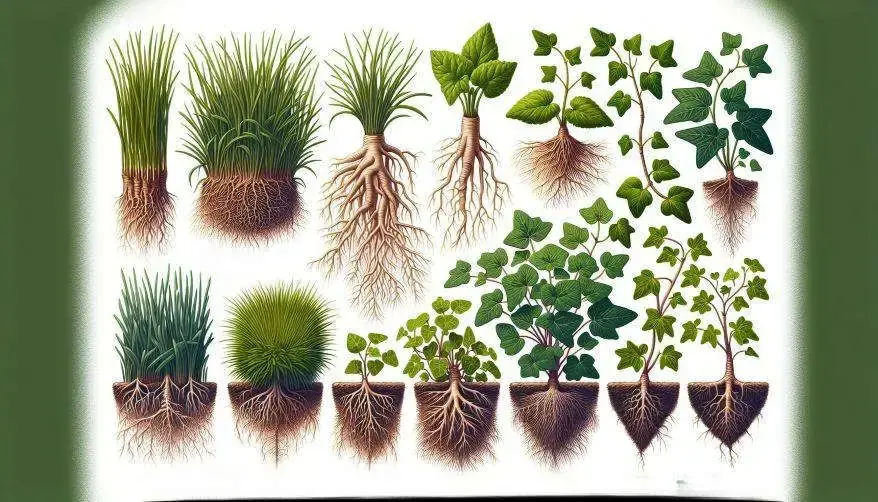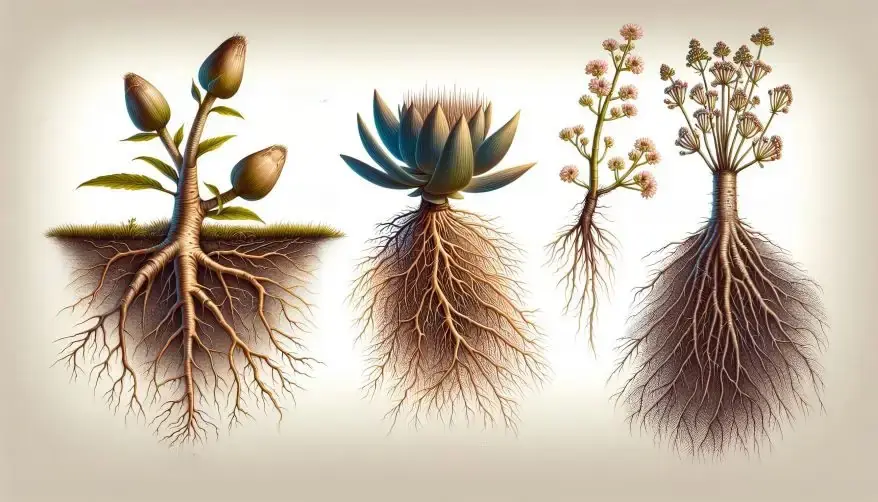5 Plant Root Types and Their Functions
Plant roots are the unsung heroes of the plant world. They do more than just hold plants in place. Roots absorb water, gather nutrients, and even store food for tough times. Without a strong root system, plants wouldn’t survive. Did you know there are different plant root types, each with its own job? Understanding these can help you grow healthier plants and improve your gardening skills.

1. Taproots: The Deep Anchors
Characteristics of Taproots
Taproots are like the main highway of a plant’s root system. They feature a primary root that grows straight down into the soil, with smaller secondary and tertiary roots branching off. This structure makes them stand out from other types of roots. You’ll often find taproots in dicotyledonous plants, like carrots or radishes.
One cool thing about taproots is their ability to take on different shapes. Some are conical, like a carrot, while others are fusiform (spindle-shaped) or napiform (turnip-shaped). These shapes aren’t just for looks—they help the plant store food or dig deep into the soil. Taproots can grow very deep, which is why they’re great at finding water and nutrients in places other roots can’t reach. This deep growth also gives the plant extra stability, especially in tough conditions like high winds or heavy rain.
However, taproots face challenges in compacted or clay-heavy soils. These soils can restrict root growth, reduce aeration, and make it harder for water to seep through. Despite these obstacles, taproots remain a vital part of many plants’ survival strategies.
Functions of Taproots
Taproots are like the multitaskers of the plant world. Their primary job is to anchor the plant firmly in the soil. This stability is especially important for low-rooted trees and plants in windy or rainy areas. A strong taproot keeps the plant from toppling over.
Another key function is nutrient absorption. Taproots dig deep into the soil, reaching water and minerals that other roots might miss. This makes them especially useful in drought-prone environments, where surface water is scarce. Hence, taproots are more efficient at absorbing water and minerals compared to fibrous roots, as shown in the table below:
| Root Type | Nutrient Absorption Capability |
|---|---|
| Taproot | More efficient in absorbing water and minerals. |
| Fibrous Root | Absorbs water more efficiently as it reaches deep into the soil. |
Examples of Taproot Plants
You’ve probably seen taproots in action without even realizing it. Common examples include carrots, radishes, and beets. These plants have taproots that are not only functional but also edible. Other examples include dandelions and turnips. Eventually, some trees, like oaks and pines, rely on taproots for stability and nutrient absorption.
Taproots are essential for plants with a small root system or those growing in challenging environments. They provide the strength and resources plants need to thrive. Hence, taproots are a perfect example of nature’s ingenuity, helping plants adapt and survive in diverse conditions.
2. Fibrous Roots: The Surface Spreaders
Characteristics of Fibrous Roots
Fibrous roots are like a fine web spreading beneath the soil’s surface. Unlike taproots, these roots don’t have a single dominant root. Instead, they consist of a dense network of thin, thread-like roots that grow outward and downward. This root system is common in monocotyledonous plants, such as grasses and wheat.
One standout feature of fibrous roots is their ability to penetrate soil to depths of 30-60 cm (12-24 inches). Hence, this depth might not seem impressive compared to taproots, but it’s perfect for plants that need to absorb nutrients and water from the upper layers of the soil. These plant root types also improve soil structure by loosening compacted soils, enhancing aeration, and allowing water to seep more easily.
Fibrous root systems are excellent at holding soil in place because they are thin, extensive, and weblike. This is why various types of grasses, which have fibrous root systems, are planted in areas that are subject to erosion from flowing water following rains.
Functions of Fibrous Roots
Fibrous roots are nature’s solution to soil erosion. Their extensive network grips the soil tightly, preventing it from washing away during heavy rains. Thus, this makes them ideal for stabilizing slopes or areas prone to erosion. If you’ve ever noticed how grasses thrive on hillsides, it’s thanks to their fibrous roots.
These roots also excel at absorbing water and nutrients from the topsoil. Certainly, their widespread reach ensures that no resource goes to waste. This is especially beneficial for plants with a small root system, as it allows them to maximize nutrient uptake without needing to dig deep. Additionally, fibrous roots improve soil porosity, making it easier for air and water to move through the soil.
Another fascinating function is their role in improving soil health. As fibrous roots grow and die, they leave behind organic matter that enriches the soil. This process creates a healthier environment for future plants.
Examples of Fibrous Root Plants
You’ll find fibrous roots in many everyday plants. Here are a few examples:
Fenugreek: Its fibrous roots can reach depths of 30-60 cm, loosening compacted soils and improving aeration.
Grasses: These plants are often used to prevent soil erosion due to their weblike root systems.
Wheat and rice: These crops rely on fibrous roots to absorb nutrients efficiently from the topsoil.
Fibrous roots are also common in plants with low-rooted trees or shrubs. Thus, their ability to stabilize soil and absorb nutrients makes them a vital part of many ecosystems. Whether growing crops or maintaining a lawn, understanding this type of root can help you make better planting decisions. Similarly, the strength of a thriving plant lies in its roots, and fibrous roots play a crucial role in this process.

3. Adventitious Roots: The Opportunists
Characteristics of Adventitious Roots
Adventitious roots are unique because they don’t grow from the plant’s primary root system. Instead, they sprout from unexpected places like stems, leaves, or old roots. These roots are opportunistic, forming wherever the plant needs extra support or resources. You’ll often see them in plants with a small root system or those growing in challenging environments.
One fascinating feature of adventitious roots is their adaptability. Similarly, they can grow above or below the ground, depending on the plant’s needs. For example, aerial roots, a type of adventitious root, grow above the soil and absorb moisture from the air. Some adventitious roots even thicken to provide extra stability or store nutrients. This flexibility makes them a survival tool for many plants.
Functions of Adventitious Roots
Adventitious roots are multitaskers, performing several critical roles for plants. Here’s what they do:
Water and nutrient absorption: Aerial roots, common in epiphytes like orchids, absorb moisture and nutrients directly from the air. This is essential for plants that don’t grow in soil.
Anchoring and stability: In climbing plants like ivy, adventitious roots attach to surfaces, helping the plant grow upward and stay secure.
Gas exchange and respiration: Some adventitious roots, like those in mangroves, facilitate gas exchange in swampy, low-oxygen environments.
Vegetative reproduction: When these roots touch the soil, they can develop into a new root system, allowing the plant to spread and grow.
Protection and support: Thickened adventitious roots, like those in banyan trees, provide extra support and protect the plant from harsh conditions.
Therefore, these functions make adventitious roots a vital part of many plants’ survival strategies. They’re especially useful in plants with invasive root systems, as they allow the plant to spread quickly and adapt to new environments.
Examples of Adventitious Root Plants
You’ll find adventitious roots in a variety of plants. Climbing plants like ivy and pothos use these roots to cling to walls and trees. Epiphytes such as orchids rely on aerial roots to absorb moisture and nutrients from the air. Mangroves grow in swampy areas and use adventitious roots for gas exchange and stability.
Other examples include the banyan tree, which develops thick aerial roots for support, and sweet potatoes, where adventitious roots store nutrients. Eventually, some low-rooted trees like corn use adventitious roots to stabilize themselves in loose soil. Adventitious roots show how plants adapt to their surroundings. These roots embody that adaptability, helping plants thrive in diverse environments.
4. Aerial Roots: The Air Absorbers
Characteristics of Aerial Roots
Aerial roots are fascinating because they grow above the ground instead of digging into the soil. These roots are often found in plants that live in humid or tropical environments. Hence, they’re specially adapted to absorb moisture and nutrients directly from the air. Some aerial roots, like those in orchids, are covered with a spongy tissue called velamen. Therefore, this tissue acts like a sponge, soaking up water from rain, dew, or fog.
What makes aerial roots unique is their versatility. They can stabilize plants, help them climb, or even assist in gas exchange. For example, mangroves use aerial roots called pneumatophores to breathe in swampy areas where oxygen is scarce. Other plants, like monstera, use their aerial roots to climb toward sunlight. These roots are a perfect example of how plants adapt to their surroundings.
Functions of Aerial Roots
Aerial roots play several important roles. First, they absorb moisture and nutrients from the air, which is crucial for plants like orchids that don’t grow in the soil. These roots collect water from rain or mist, ensuring the plant stays hydrated. The velamen tissue helps them do this efficiently by trapping water and passing it to the plant.
Second, aerial roots provide stability. Similarly, plants like mangroves and banyan trees use these roots to anchor themselves in soft or unstable soil. This keeps them upright even in challenging conditions. Climbing plants, such as monstera and ivy, use aerial roots to attach to surfaces, allowing them to grow upward and reach more sunlight.
Lastly, aerial roots help with gas exchange. In swampy areas, where oxygen levels in the soil are low, plants like mangroves rely on their aerial roots to breathe. Thus, these roots stick out of the water and take oxygen directly from the air.

Examples of Aerial Root Plants
You’ve probably seen aerial roots in action without realizing it. Here are some examples:
Orchids: Their thick, fleshy roots absorb water and nutrients from the air.
Monstera deliciosa: These roots help the plant climb and stabilize itself.
Ficus pumila (climbing fig): Its small roots cling to walls and other surfaces.
Mangroves: They use pneumatophores for gas exchange and buttress roots for stability.
Tillandsia (air plants): These roots absorb moisture from the air, making them perfect for humid environments.
As you can see, aerial roots are incredibly versatile. They help plants survive in environments where traditional roots might struggle. Certainly, aerial roots remind us of nature’s ability to adapt and thrive in even the most challenging conditions.
5. Storage Roots: The Nutrient Reserves
Characteristics of Storage Roots
Storage roots are like nature’s pantry, storing energy-rich compounds to help plants survive tough conditions. These roots swell up because they’re packed with starches, sugars, and other nutrients. This makes them different from other roots, like taproots or fibrous roots, which focus more on anchoring or absorbing water. Storage roots usually grow underground, which protects them from herbivores and harsh weather.
What’s fascinating is how these roots adapt to their environment. For example, sweet potatoes and cassava thrive in poor soils and low rainfall areas. Their ability to store nutrients not only helps the plant but also makes them valuable crops for humans. Hence, these plant root types are a perfect example of how plants use their root system to store energy and ensure survival.
Functions of Storage Roots
Storage roots do more than just hold nutrients. They act as a backup plan for plants, storing food during good times so the plant can use it during droughts or when growth conditions aren’t ideal. Thus, this stored energy also helps plants regrow after being cut or damaged.
Another important role is reproduction. Some storage roots, like those in sweet potatoes, can sprout new plants. This makes them a natural tool for vegetative propagation. Farmers often use this feature to grow crops more efficiently.
Therefore, these roots also play a big role in agriculture. Crops like carrots, beets, and cassava are grown worldwide because of their storage roots. They’re not just nutritious but also versatile in cooking. For instance, cassava is a staple food in tropical regions and can be turned into flour, chips, or tapioca.
Examples of Storage Root Plants
You’ve probably eaten storage roots without even realizing it. Here are some common examples:
Cassava (Manihot esculenta): A major carbohydrate source in tropical areas. It grows well in poor soils and is used in many dishes.
Sweet potatoes (Ipomea batatas): Known for their adaptability and importance in traditional diets, especially in Hawaii.
Carrots and beets: Packed with nutrients and often used in salads, soups, and juices.
Turnips and radishes: Popular in many cuisines for their crunchy texture and unique flavors.
Sugar beets: A key source of sugar in many countries.
These plants highlight the importance of storage roots in both agriculture and daily life. Similarly, the greatest innovation in plants might just be their ability to store energy in their roots, ensuring survival and growth.

Conclusion
Plant roots are more than just anchors; they’re the lifeline of every plant. Each plant root type—from taproots to aerial roots—has a unique role in keeping plants healthy and thriving. Further, by understanding these systems, you can make smarter choices in gardening or farming. For example:
Taproots work best in drought-prone areas, helping crops like carrots access deep moisture.
Fibrous roots thrive in rainy regions, efficiently using surface water.
Learning about roots can lead to sweeter results in your garden or farm. 🌱
FAQ’s
1. What are the main plant root types?
Plants have five main root types: taproots, fibrous roots, adventitious roots, aerial roots, and storage roots. Each type serves a unique purpose, like anchoring the plant, absorbing nutrients, or storing food.
2. How do taproots differ from fibrous roots?
Taproots grow deep into the soil with one main root, while fibrous roots form a dense, shallow network. Taproots are great for stability and drought resistance, while fibrous roots prevent soil erosion and absorb surface nutrients.
3. Why are adventitious roots important?
Adventitious roots grow from unexpected places like stems or leaves. They help plants adapt by providing extra support, absorbing nutrients, or even aiding in plant propagation.
4. Can aerial roots harm structures?
Yes, some plants with aggressive root systems, like ivy, can damage walls or buildings. These roots cling tightly to surfaces, which may cause cracks or structural issues over time.
5. What are storage roots used for?
Storage roots, like those in carrots or sweet potatoes, store nutrients and energy. This helps plants survive harsh conditions and regrow after damage.
References
- Ryan, P. R., Delhaize, E., Watt, M., & Richardson, A. E. (2016). Plant roots: understanding structure and function in an ocean of complexity. Annals of Botany, 118(4), 555–559. https://doi.org/10.1093/aob/mcw192
- Gonin, M., Bergougnoux, V., Nguyen, T. D., Gantet, P., & Champion, A. (2019). What makes adventitious roots? Plants, 8(7), 240. https://doi.org/10.3390/plants8070240
- Etherington, J. R., & Atkinson, D. (1992). Plant root growth: an ecological perspective. Journal of Ecology, 80(2), 367. https://doi.org/10.2307/2261019
- Lux, A., & Rost, T. L. (2012). Plant root research: the past, the present and the future. Annals of Botany, 110(2), 201–204. https://doi.org/10.1093/aob/mcs156
- Schmidt, W. (2014). Root systems biology. Frontiers in Plant Science, 5. https://doi.org/10.3389/fpls.2014.00215
Additionally, to stay updated with the latest developments in STEM research, visit ENTECH Online. Basically, this is our digital magazine for science, technology, engineering, and mathematics. Further, at ENTECH Online, you’ll find a wealth of information.






